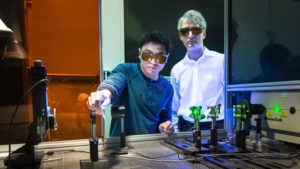
Oak Ridge National Laboratory’s (ORNL) researching team developed a laser process that could make joining carbon fiber composites and aluminum less expensive with more robust joints as a result. The process promises cheaper lightweight, high-end components for use in automotive manufacture.
The joining of carbon fiber composites and aluminum requires that the joined surfaces be clear of things that interfere with the bonding agents. Aluminum surfaces typically have oils and contamination from production rolling, while carbon fiber often has mold releases from the manufacturing process.
The current practice for joining these two materials involves hand-preparing surfaces with abrasive pads and solvents. This is both labor-intensive and harmful to the environment. The ORNL team has designed a process in which lasers remove the layers of material from surfaces instead. The laser process penetrates into the outermost layers of the materials, leaving clean unblemished aluminum and exposed carbon fibers to allow for direct bonding, resulting in a better bonding surface and a path towards automation of the process in high-volume use.
Testing showed the strength of single-lap shear joint specimens and the maximum load required to break the joint increased by 15 and 16 percent, respectively, as compared to baseline joints using conventional adhesion processes. Joints made with the laser-structured surface can also absorb approximately 200 percent more energy, which has implications in crash safety and industrial armor. Project partner Magna International is encouraged by the findings and hopes to begin utilizing the process in manufacture. Adrian Sabau, team leader for the ORNL-lead research, will present findings at the upcoming Advancement of materials and Process Engineering conference on May 23-26 in Long Beach, California.
The process could lead to more industry adoption of aluminum and carbon fiber, especially in automotive. “Our technique is vastly superior to the conventional surface preparation methods,” says Sabau. “Combined with the potentially dramatic reduction in the cost of carbon fiber polymer composites, this represents an important step toward increasing the use of this lightweight high-strength material in automobiles, which could reduce the weight of cars and trucks by 750 pounds (340 kg).”



